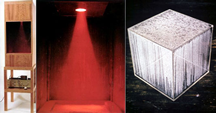September 22, 2006
Heart Beats Dust by Jean Dupuy

An E.A.T. Experiment
A colleague discussing research with me on friday told me of an early electronic / electrical work which clearly indicates the direction art would start to pursue over the next thirty years and fits nicely into my area of research. The work, mentioned in the publication Digital Currents by Margot Lovejoy, entitled Heart Beats Dust (above left and centre) by Jean Dupuy is a work I had never seen by an artist I had never heard of and strangely seems to be omitted from any other history of media art I am aware of (or the few conceptual art histories I have covered so far). It makes you wonder about who writes these histories and how they decide to include some works and not others.
Heart Beats Dust consists of:
a black rectangular box, a window at eye level opens onto a 24′ cube which houses the sculpture. The form is created by thrusting dust up into a cone of light. The dust is Lithol Rubine, a brilliant red pigment chosen for its ability to remain suspended in air for long periods. The thrust is achieved by amplified heart-beats from an attached stethoscope or a continuous loop tape recording of heartbeats played on a speaker mounted directly under a tightly stretched rubber membrane upon which the dust sits. (medienkunstnetz.de)
There is work reminiscent of Hearts Beats Dust particularly conceptual work such as Hans Haacke’s Condensation Cube (1963-65, above right) in that it too uses a basic medium (water) to show processes in action (condensation cycles) however nothing which cleverly brings technology and art, electronics and visualisation of the invisible together as cleverly.
Heart Beats Dust was the winning entry in a competition for collaborations between artists and engineers entitled E.A.T. (Experiments in Art and Technology) which also anticipated major initiates by organisations such as Xerox with their PAIR program and HP Labs with their Creative Residencies. [blogged by Garrett Lynch on Network Research]
Posted by jo at September 22, 2006 05:04 PM
